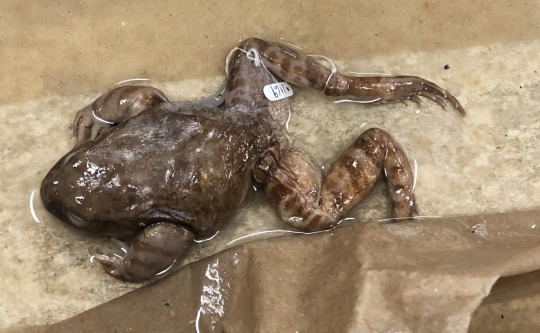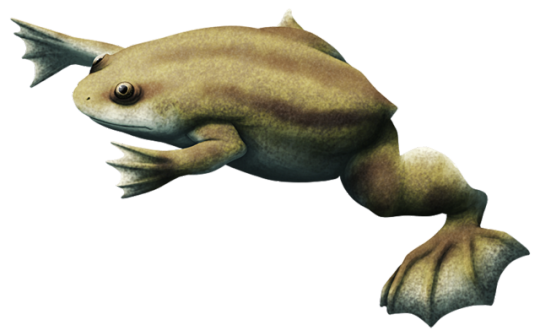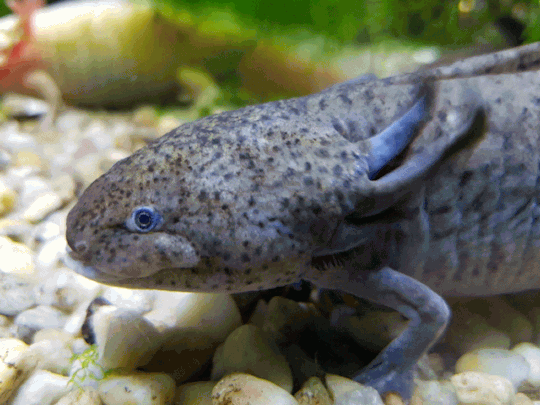#lissamphibia
Text

Biofluorescense is the term for when living organisms "glow" under certain types of light. Although it's not usually directly visible to human eyes, wavelengths such as ultraviolet can reveal it – and we're still only just starting to discover how widespread it really is in nature.
This phenomenon has been found in all major groups of modern amphibians, with most of them glowing green under UV, suggesting that it originated in their ancestors at least 300 million years ago.
So, ancient species like Funcusvermis gilmorei here could probably glow green, too!
Living during the late Triassic (~220 million years ago), fossils of Funcusvermis were found in what is now Arizona, USA. It's only known from fragmentary remains, but those pieces are distinctive enough to identify it as the earliest known relative of modern caecilians.
It had a caecilian-like jaw with two rows of teeth, but unlike its worm-like modern relatives it still had small legs and wasn't as highly specialized for burrowing. The shape of its vertebrae suggest it had a tubular body, and while its exact proportions and full length are unknown it may have been comparable in size to the smallest modern caecilians, around 10cm long (~4").
Its combination of anatomical features gives further support to the idea that all modern amphibians share a common ancestor among the dissorophoid temnospondyls. The more distantly related but also caecilian-like Chinlestegophis may be a case of convergent evolution, representing a separate branch of temnospondyls that were coincidentally exploring a similar sort of lifestyle at around the same time.
———
NixIllustration.com | Tumblr | Twitter | Patreon
#science illustration#paleontology#paleoart#palaeoblr#funcusvermis#gymnophiona#caecilian#stem-caecilian#lissamphibia#amphibian#art#speculative glowiness#biofluorescence#nature's invisible rave
237 notes
·
View notes
Text
Amateur tranny fingers her new pussy
Pinoy celebrity hunk gay porn Our insane cameraman got the greatest
Sweet ass teen rides bbc
Single Dude Gets to Fuck Two Hot Babes
Sugary girl Scarlett Mae is fucked for hours
Hot Latina Dancing fire
Young teen caught masturbating Russian Language Power
Vietnam bigo
bisexual crossdresser gets fucked by a dildo machine on full power while masturbaiting and shooting a cumshot at the same time
Latina fucks her car
#curviness#sand-etched#axmen#choko#Delsarte#planneraddict#supraglottic#twibil#ekebergite#Boarer#Lissamphibia#tragics#interpapillary#freemasonism#twice-evaded#optative#pantelegraph#ungradually#chalcographer#fascioliasis
2 notes
·
View notes
Text


0030252226142122 08261426221022
0022303426 30131318211326 301730 1610252114212113 05263014
00063016182504 302522261418143021
002234180804 1503212205 2613 0113300814 0613260122
0025180721 1808 2226100503 30162113181530 21081421161815 0526 343005300126081830
0016302521 1421072125263422 223418082122 2608 050321 1503212205 0526 01131834 062116302521
2 notes
·
View notes
Text
Caecilians, everyone's favorite weird amphibian. Got a hunch its weak to fire. Dessicate that thing.
#critical role#critical role spoilers#funky little worm looking amphibians#gymnophiona. i could never spell you right.#always forgot when i needed to list the orders of lissamphibia for my vert anatomy class
6 notes
·
View notes
Text
world’s lamest lazarus taxa
#all the care guide says is 'biomass'#yes this is about miri#i am Yet Again thinking about merfolk evolutionary pressures#and why their group is so unique among amphibians and made it to modern day while the only other amphibians we have are lissamphibia
5 notes
·
View notes
Text

(( Since learning about albanerpetontids, I’ve decided to place my merfolk within Amphibia proper. They still aren’t within Lissamphibia, being as they’d be more related to more extinct amphibians than any modern amphibians, but! Amphibians regardless!
#Most secret royal advisor || OOC#Given by Divine Right || Headcanons#(( i think the last bit of curiosity about where they fit within amphibia#(( has to do with their gills#(( namely their dual internal and external gills#(( and then i can improve on their skulls a lil#(( meanwhile zero doubt for me that kappa are lissamphibia
3 notes
·
View notes
Text

Squat Frog (Glyphoglossus capsus), family Microhylidae, Borneo
Described in 2014.
This frog was originally in the genus Calluella. This genus has now been placed in the genus Glyphoglossus.
photograph via:
Red hot chili pepper. A new Calluella stoliczka, 1872 (Lissamphibia: Anura: Microhylidae) from Sarawak, East Malaysia (Borneo) - PubMed (nih.gov)
453 notes
·
View notes
Text
ribbit ribbit let's destroy linneaus some more
thanks to @quark-nova for the excellent clade options
205 notes
·
View notes
Text
Time to decide of the ultimate chordate species, let's first find out which class it belongs to!
Don't forget to share so as many people as possible can do the silly poll!
15 notes
·
View notes
Photo

Triassic stem caecilian supports dissorophoid origin of living amphibians
Ben T. Kligman, Bryan M. Gee, Adam D. Marsh, Sterling J. Nesbitt, Matthew E. Smith, William G. Parker & Michelle R. Stocker
Abstract
Living amphibians (Lissamphibia) include frogs and salamanders (Batrachia) and the limbless worm-like caecilians (Gymnophiona).
The estimated Palaeozoic era gymnophionan–batrachian molecular divergence suggests a major gap in the record of crown lissamphibians prior to their earliest fossil occurrences in the Triassic period.
Recent studies find a monophyletic Batrachia within dissorophoid temnospondyls, but the absence of pre-Jurassic period caecilian fossils has made their relationships to batrachians and affinities to Palaeozoic tetrapods controversial.
Here we report the geologically oldest stem caecilian—a crown lissamphibian from the Late Triassic epoch of Arizona, USA—extending the caecilian record by around 35 million years. These fossils illuminate the tempo and mode of early caecilian morphological and functional evolution, demonstrating a delayed acquisition of musculoskeletal features associated with fossoriality in living caecilians, including the dual jaw closure mechanism, reduced orbits and the tentacular organ.
The provenance of these fossils suggests a Pangaean equatorial origin for caecilians, implying that living caecilian biogeography reflects conserved aspects of caecilian function and physiology, in combination with vicariance patterns driven by plate tectonics.
These fossils reveal a combination of features that is unique to caecilians alongside features that are shared with batrachian and dissorophoid temnospondyls, providing new and compelling evidence supporting a single origin of living amphibians within dissorophoid temnospondyls.
Read the paper here:
https://www.nature.com/articles/s41586-022-05646-5
6 notes
·
View notes
Note
water
Amphibians are four-limbed and ectothermic vertebrates of the class Amphibia. All living amphibians belong to the group Lissamphibia. They inhabit a wide variety of habitats, with most species living within terrestrial, fossorial, arboreal or freshwater aquatic ecosystems. Thus amphibians typically start out as larvae living in water, but some species have developed behavioural adaptations to bypass this.
2 notes
·
View notes
Photo


Arhuaco community of Colombia allows scientists to photograph 'lost' toad
For nearly 30 years, the starry night harlequin toad (Atelopus arsyecue), a tiny amphibian, named for its glossy black skin with white spots that resembles a starry, dark sky, remained undetected by scientists. But the indigenous Arhuaco people of the Sogrome community living in Colombia’s Sierra Nevada de Santa Marta, one of the world’s tallest coastal mountains and the only place the toad is known from, have been residing alongside the species for generations. They not only share their mountain home with the toad, but consider the animal sacred and an integral part of their culture. According to the Arhuaco people, gouna, as the toad is locally known, tells them about their environment, indicating the right time to plant crops or perform spiritual ceremonies.
“The Sierra Nevada de Santa Marta is a place that we consider sacred, and harlequin toads are guardians of water and symbols of fertility,” Kaneymaku Suarez Chaparro, a member of the Sogrome community and a biology student at the Francisco José de Cladas District University, said in a statement.
Recently, the community opened its doors to some conservation biologists, allowing them to take photographs of the critically endangered toads and share them with the wider scientific community, the U.S.-based Global Wildlife Conservation (GWC) announced in a press release.
“With the starry night harlequin toad records, we confirm that Sierra Nevada de Santa Marta is one of the most important sites for the conservation of harlequin toads in Latin America,” Luis Alberto Rueda, a professor at Universidad del Magdalena and cofounder of Fundación Atelopus, said in the statement. Fundación Atelopus is the Colombian NGO that partners with GWC and is working to document the toad.
“We are tremendously grateful to the Arhuaco people for giving us this opportunity to work with them,” added Lina Valencia, Colombia conservation officer at GWC.
Harlequin toads, a group of vibrant toads found in the American tropics, are among the world’s most threatened amphibians. Of the 96 known species of harlequin toads, 80 are endangered, critically endangered or extinct in the wild, according to the IUCN Red List. The deadly chytrid fungus in particular, which has decimated amphibian populations around the world, has hit the harlequin toads hard. And researchers were worried that the starry night harlequin toad, which hadn’t been recorded by scientists in nearly three decades, had been wiped out by the fungal disease.
#Starry Night Harlequin Toad#Atelopus arsyecue#Atelopus#Bufonidae#Neobatrachia#Anura#Lissamphibia#Amphibia#amphibian#toad#endangered#Colombia
255 notes
·
View notes
Photo

Almost-Living Fossils Month #25 -- Europe’s Fully Aquatic Frogs
The palaeobatrachids were a group of frogs, part of a fairly “primitive” lineage that also includes the living pipids. They first appeared in the fossil record about 70 million years ago in the Late Cretaceous, but may have actually originated much earlier, perhaps as far back as the Late Jurassic (~145 mya).
These frogs lived mainly in Europe, with a few possible remains also known from North America in the Cretaceous. They were fully aquatic, spending their entire lives in water, and fully-grown adults looked similar to modern Xenopus clawed frogs, with slightly flattened egg-shaped bodies, upwards-facing eyes, and long fingers and toes.
Some fossils preserve soft-tissue impressions, showing internal organs such as unusual bag-shaped lungs. Eggs and juveniles have also been found, and while most species’ tadpoles usually reached lengths of around 6cm (2.4″), a few were comparatively gigantic, growing to over twice that size.
The end-Cretaceous extinction (~66 mya) had little overall effect on the palaeobatrachids, and they continued to thrive in the warm wet environments of Europe during the early Cenozoic. But as climates in Western Europe gradually became drier and cooler starting in the Early Oligocene (~33 mya) they mostly disappeared from that region and instead shifted east towards Central and Eastern Europe, ranging as far as Russia.
By the Late Pliocene (~3 mya) they were struggling to cope with the ongoing cooling and drying, and the onset of the Pleistocene glaciations made things even worse for them.
Palaeobatrachus langhae was probably the last species of these frogs, known from the Early Pliocene to the mid-Pleistocene (~5 mya - 500,000 years ago). Growing to about 10cm long (4″), it lived in some of the final refuges of the palaeobatrachids in Eastern Europe, inhabiting inland temperate areas where winter temperatures weren’t too harsh.
Unfortunately the palaeobatrachids didn’t quite manage to make it through the Ice Age, ending up trapped by their fairly specialized habitat preferences. During repeated glacial periods the temperatures became too cold for them, freezing the water they depended on, but the warmer climates to the south were also too dry for them to migrate into -- and with nowhere to go, they finally went completely extinct just half a million years ago.
#almost living fossils month#science illustration#paleontology#paleoart#palaeoblr#palaeobatrachus#palaeobatrachidae#pipimorpha#anura#frog#salientia#batrachia#lissamphibia#amphibian#art
163 notes
·
View notes
Text


001521133005263403130422 15261308100530
0022101318083016 032613082114 06132601
00063016182504 1521133005263403130418143021
00032613082114 0526301422
002530130121 1626100503
00221805 300814 29301805 341321143005261322 29180503 30 07211304 01210821133025182205 14182105
0022261621 03300721 0625212203 3413260513102218260822 2608 050321 052634 2606 050321 21042125181422
1 note
·
View note
Photo

Moving oxygenated water
#original photographers on tumblr#axolotl#Ambystoma mexicanum#mexican salamander#gif#Lissamphibia#herpetology
1K notes
·
View notes
Photo


A Nicklin’s shoulderband snail (Helminthoglypta nickliniana anachoreta) chills with his salamander friend (a California slender salamander, Batrachoseps attenuatus) under a piece of fallen bark. Sonoma County, California, January 2017.
Fun fact: only one of these animals possesses lungs (hint: it’s not the salamander)
#snail#gastropoda#mollusca#pulmonata#land snail#salamander#slender salamander#urodela#caudata#amphibian#lissamphibia#malacology#herpetology#herpblr#plethodontidae
245 notes
·
View notes